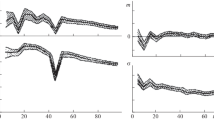Abstract
Relative variations in the critical frequency of the ionospheric F, region are considered as one of the main sources of information about the characteristics of plasma inhomogeneities in the region of the main ionization maximum and as a substantial factor responsible for the statistics of the decameter signal parameters on radio paths with different lengths. The functions defined on finite intervals are also used in statistical modeling in addition to the available methods. Such a consideration made it possible to remove a restriction, peculiar to previous models, in the form of the requirement that the fourth statistical invariant—excess— should be positive. This makes the generalized statistical model more universal, which is of special importance for high4atitude radio paths. The specified mo del more adequately corresponds to the experimental data, which are characterized by finite intervals where the quantities are measured.
Similar content being viewed by others
References
K. Davies, Ionospheric Radio Waves, (Blaisdell, Waltham, 1969; Mir, Moscow, 1973).
A. L. Dzvonkovskaya, V. A. Kuznetsov, and N. P. Sergeenko, “One-Dimensional Statistics of the Relative Variations in the Critical Frequency of the Ionospheric F 2, Layer at Different Latitudes,” Geomagn. Aeron. 44(6), 813–816 (2004) [Geomagn. Aeron. 44, 751–755 (2004)].
T. V. Gaivoronskaya, N. P. Sergeenko, and L. A. Yudovich, “Deviation of the F, Region Critical Frequencies from Median Values,” in Ionospheric Disturbances and Their Effect on Radiocommunication, (Nauka, Moscow, 1971), pp. 55–73 [in Russian].
V. L. Ginzburg, The Propagation of Electromagnetic Waves,in Plasmas,, 2nd ed. (Nauka, Moscow, 1967; Pergamon Press, Oxford, 1970).
Handbook of Mathematical Functions,, Ed. by M. Abramowitz and I. A. Stegun (Dover, New York, 1965; Nauka, Moscow, 1979).
Ionospheric—Magnetic Service,, Ed. by S. I. Avdyushin and A. D. Danilov (Gidrometeoizdat, Leningrad, 1987) [in Russian].
D. Middleton, An Introduction to Statistical Communication, Theory, (McGraw Hill, New York, 1960; Sov. Radio, Moscow, 1961).
G. N. Watson, Theory of Bessel Functions, (Inostr. Liter., Moscow, 1949).
I. S. Vsekhsvyatskaya, N. P. Sergeenko, and L. A. Yudovich, “On Statistical Regularities of NmF2, Fluctuations at Midlatitudes,” Geomagn. Aeron. 10(4), 606–609 (1970).
I. S. Vsekhsvyatskaya, N. P. Sergeenko, and L. A. Yudovich, “Statistical Model of Geophysical Processes with Asymmetry and Excess of Probability Density Functions,” Geomagn. Aeron. 11(5), 785–788 (1971).
E. M. Zhulina and M. V. Kiseleva, “On Specific Features of the foF2, Statistical Distributions at High Latitudes,” in Studying the F Region and Outer Ionosphere, (IZMI-RAN, Moscow, 1974), pp. 275–279 [in Russian].
Author information
Authors and Affiliations
Additional information
Original Russian Text © Yu.K. Kalinin, N.P. Sergeenko, A.L. Dzvonkovskaya, V.A. Kuznetsov, T.D. Platonov, V.V. Velichko, 2010, published in Geomagnetizm i Aeronomiya, 2010, Vol. 50, No. 1, pp. 67–71.
Rights and permissions
About this article
Cite this article
Kalinin, Y.K., Sergeenko, N.P., Dzvonkovskaya, A.L. et al. Statistical modeling of relative variations in the critical frequencies of the ionospheric F region. Geomagn. Aeron. 50, 64–68 (2010). https://doi.org/10.1134/S0016793210010081
Received:
Accepted:
Published:
Issue Date:
DOI: https://doi.org/10.1134/S0016793210010081




